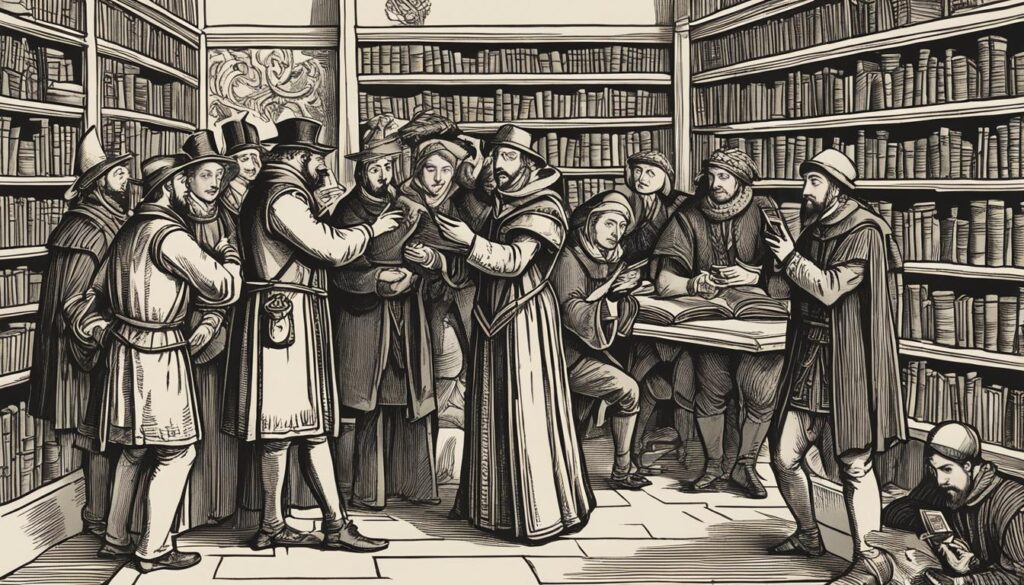In this comprehensive audiobook review, we take a close look at Peter Ackroyd’s adaptation of the classic book, “The Canterbury Tales” by Geoffrey Chaucer. The 14th-century collection of stories comes alive in this modern retelling, narrated and performed by a talented voice cast. We explore the audiobook’s narration, performances, character development, themes, and more, evaluating its merits as an audiobook experience. Whether you’re a long-time fan of Chaucer’s work or seeking a new listen, read on for our expert analysis of “The Canterbury Tales” by Peter Ackroyd.
Overview of “The Canterbury Tales”
Geoffrey Chaucer’s “The Canterbury Tales” is a collection of stories told by a diverse group of pilgrims traveling to the shrine of Thomas Becket in Canterbury. The tales were written in Middle English and span a range of genres, from romance and comedy to morality tales and tragedy. Chaucer’s work is widely regarded as a masterpiece of English literature and a landmark in the development of the English language.
The tales themselves are framed by the journey of the pilgrims and the interactions that occur among them. This structure allows for a rich exploration of medieval society, including themes of class, gender, religion, and human nature. The characters are vividly drawn and range from the noble to the vulgar, offering a panoramic view of the world as it was in Chaucer’s time.
Historical Significance
Chaucer wrote “The Canterbury Tales” in the late 14th century, a time of great upheaval in England. The Black Death had ravaged the population, and social and economic changes were transforming the country. Chaucer’s work reflects these changes, as well as the political and religious tensions of the time.
Structural Innovations
One of the most innovative aspects of “The Canterbury Tales” is its structure. Chaucer employs a frame narrative, in which the individual stories are embedded within a larger narrative. This device allowed him to explore a wide range of subjects and viewpoints while maintaining an overarching unity of theme. Chaucer also made frequent use of irony and satire, skewering the hypocrisies and follies of his contemporaries.
The tales are also notable for their use of vernacular language, which helped to establish English as a literary language in its own right. Prior to Chaucer, most literature was written in Latin or French, but his use of Middle English paved the way for later writers such as Shakespeare.
Introduction to Peter Ackroyd
Peter Ackroyd is an acclaimed author known for his extensive work in literature, biography, and history. Born in London in 1949, Ackroyd began his career as a writer in the mid-1970s, quickly establishing himself as a prominent voice in the literary world. His background in history and literature has deeply influenced his writing, capturing the attention of readers with his unique perspectives and insights.
Ackroyd’s works have won numerous awards, including the Whitbread Biography Award, the Guardian Fiction Prize, and the Somerset Maugham Award. His most notable works include biographies on figures such as William Shakespeare and Charles Dickens, and his critically-acclaimed novel “Hawksmoor.”
With a deep appreciation for both history and literature, it’s no surprise that Peter Ackroyd turned his attention to Geoffrey Chaucer’s “The Canterbury Tales” in his audiobook adaptation. Ackroyd’s experience and background provide valuable insights into his approach to adapting this beloved classic, breathing new life into the work through his unique lens.
The Audiobook Format
Listening to “The Canterbury Tales” through an audiobook offers a unique and immersive experience. The format allows for a hands-free listening experience, enabling the listener to multitask while still enjoying the story. One potential drawback of the audiobook format is that it may not suit readers who prefer to take in the text at their own pace.
Peter Ackroyd’s audiobook adaptation of “The Canterbury Tales” is an excellent way to experience the story for the first time or rediscover it in a new light. The audiobook format enhances the storytelling and takes the listener on an unforgettable journey.
The audiobook format also provides rich production elements that add to the listening experience. These elements include sound design, music, and overall audio engineering. The sound design enhances the listener’s immersion in the story, while the music adds to the overall ambiance of the audiobook. The production quality of Ackroyd’s “The Canterbury Tales” audiobook adaptation is top-notch, ensuring a seamless and enjoyable listening journey.
Table 1. Pros and Cons of “The Canterbury Tales” Audiobook Format
| Pros | Cons |
|---|---|
| Hands-free listening experience | May not suit those who prefer to read at their own pace |
| Enhanced storytelling | An adaptive or ill-executed narration may flaw the listening experience. |
| Rich production elements like sound design and music | The audio quality may be affected due to issues like fluctuations in volume and noise in recordings. |
Table 1 highlights the pros and cons of the audiobook format of “The Canterbury Tales.” Overall, the format presents unique and engaging storytelling that enhances the listener’s experience. However, it may not suit all readers, especially those who value reading at their own pace.
Narration and Performances
Peter Ackroyd’s audiobook adaptation of “The Canterbury Tales” features an excellent cast of voice actors who bring Chaucer’s colorful characters to life. From the boisterous Miller to the meek Prioress, each character is given a distinct voice and personality that makes them easily identifiable. The narration is equally impressive, with an authoritative yet engaging tone that captures the essence of Chaucer’s original prose.
It’s worth noting that the audiobook’s production quality also enhances the performances. The sound design and music add an extra layer of immersion, transporting listeners straight to medieval England. Overall, the combination of excellent narration, impressive voice acting, and immersive sound design makes Peter Ackroyd’s audiobook adaptation a must-listen for fans of “The Canterbury Tales.”
Retelling Chaucer’s Tales
One of the hallmarks of Peter Ackroyd’s audiobook adaptation of “The Canterbury Tales” is his approach to retelling Chaucer’s stories. While Ackroyd remains faithful to the original source material in most respects, he does take certain liberties in order to modernize and adapt the tales for contemporary audiences.
For instance, Ackroyd updates certain words and phrases that might be considered archaic or outdated, making the storytelling more accessible to modern listeners. He also makes changes to the pacing and narrative flow of the tales, altering the order of certain stories and restructuring others in order to create a more cohesive overall experience.
Despite these changes, Ackroyd remains true to the spirit and tone of Chaucer’s original work, preserving the humor and social commentary that have made “The Canterbury Tales” such a beloved classic. Through his expert storytelling and command of language, Ackroyd imbues these timeless stories with new life, making them just as relevant and engaging today as they were in Chaucer’s own time.

Themes and Concepts Explored
In Peter Ackroyd’s adaptation of “The Canterbury Tales,” several themes and concepts are explored, offering a modernized perspective on Chaucer’s classic work. One of the prominent themes present in the audiobook is the examination of human nature and character, with various tales showcasing the complexities of individuals.
The concept of morality is also explored, with several tales highlighting the consequences of immoral actions. Additionally, the concept of storytelling and its power to inform and entertain is present throughout the audiobook, emphasizing the importance of sharing experiences and knowledge.
Peter Ackroyd’s adaptation offers a refreshing take on Chaucer’s themes and concepts, exploring their relevance to modern society. Through the audiobook, listeners are encouraged to contemplate the intricacies of human experiences and the impact of our actions on others.
Character Development
Peter Ackroyd’s audiobook adaptation of “The Canterbury Tales” excels in bringing Chaucer’s characters to life. The narration and vocal performances add depth and dimension to the original characters, creating a dynamic and engaging listening experience. One standout example is the portrayal of the Wife of Bath, whose complexity and nuance are captured effortlessly by one of the voice actors.
Throughout the narrative, listeners can identify the evolving character traits of the pilgrims depicted in the tales. The characters are skillfully reimagined to suit a contemporary audience, yet remain true to Chaucer’s vision. Ackroyd’s interpretation allows the audience to gain a fresh perspective on the characters and fully immerse themselves in their individual journeys.
Overall, “The Canterbury Tales” audiobook is a triumph of character development. Through an unmatched combination of storytelling and vocal performances, Ackroyd’s adaptation elevates the characters to new heights, allowing the listener to experience their tales in a manner that both respects the original source material and breathes new life into the beloved tales.
Pacing and Narrative Flow
As with any audiobook experience, pacing and narrative flow are critical to maintaining engagement and keeping listeners immersed in the story. Peter Ackroyd successfully manages to capture the energy and rhythm of Chaucer’s original work while accommodating the audio format. The narration moves at a brisk pace, preventing the story from dragging while allowing listeners to savor each character’s unique voice.
The narrative flow is smooth and seamless, transitioning between tales with ease despite the distinct differences in tone and style. The audiobook’s vibrant performances add to the liveliness of the storytelling, making it easy for listeners to remain invested in each character’s journey from start to finish.
The overall pacing and narrative flow of the audiobook adaptation make it an excellent choice for listeners looking for an immersive experience that remains faithful to Chaucer’s original work.
Historical and Literary Context
“The Canterbury Tales” is one of the most significant works in English literature, written by Geoffrey Chaucer in the late 14th century. The tales are set in the context of a pilgrimage to the shrine of Saint Thomas Becket and are written in vernacular Middle English, making them accessible to a broad audience.
Chaucer’s stories drew on medieval European folk traditions and incorporated elements of romance, satire, and realism. The tales provide insight into the social, political, and religious conditions of England in the late Middle Ages, offering a glimpse into life during a complex period of transition and upheaval.
Peter Ackroyd’s adaptation of “The Canterbury Tales” pays homage to Chaucer’s original work, while also incorporating modern elements that help bring the stories to a wider audience. This audiobook adaptation acknowledges the historical and literary contexts surrounding the original tales, including the religious divide between the Church and the common people, the influence of the feudal system on England’s social hierarchy, and the rise of vernacular literature in medieval Europe.
The Influence of Chaucer’s Work
Chaucer’s influence on English literature cannot be overstated. He helped establish Middle English as a serious literary language and paved the way for future poets and writers. His stories also provided inspiration for other notable works of literature, including William Shakespeare’s “The Merchant of Venice” and “The Wife of Bath” in “The Taming of the Shrew.”
Modern Adaptations
Peter Ackroyd’s adaptation of “The Canterbury Tales” is just one example of how Chaucer’s stories have continued to inspire new works of art over the centuries. From stage plays and operas to film adaptations and modern retellings, the tales continue to capture the imaginations of audiences around the world.
Production Quality
Production quality is a crucial component of any audiobook experience, and Peter Ackroyd’s adaptation of “The Canterbury Tales” is no exception. The sound design and music, combined with the overall audio engineering, contribute significantly to the immersive experience of the audiobook.
The sound design in the audiobook is polished and professional, with careful attention paid to creating a sense of space and depth. The use of sound effects is tasteful and adds to the overall ambiance of the story. Additionally, the music complements the tone of the individual tales, heightening the emotional impact of key moments.
The overall audio engineering of the adaptation is of high quality, ensuring that the narration and performances are clear and easy to understand. The sound levels between different sections and characters are balanced well, and the overall mix is both engaging and immersive.

Reception and Critical Response
Since its release, Peter Ackroyd’s audiobook adaptation of “The Canterbury Tales” has garnered mixed reception and critical response. While some praised the updated retelling, others criticized it for straying too far from the original source material.
Several reviewers commended the narration by Richard Lumsden, noting his engaging performance and ability to bring the characters to life. However, others expressed disappointment with the narration, finding it lackluster and lacking in energy.
Overall, the critical response to the audiobook adaptation is varied. Some critics laud Ackroyd’s fresh take on Chaucer’s tales, while others lament the changes made from the original text. In terms of reception, the audiobook has seen moderate success, with a dedicated fanbase but without reaching mainstream popularity.
“[Ackroyd’s adaptation] is vibrant and witty and well worth your time.”
– Kirkus Reviews
Comparison to Other Adaptations
Peter Ackroyd’s adaptation of “The Canterbury Tales” is just one of many retellings of this classic work of literature. To evaluate its unique contributions, it is essential to compare it with other adaptations that have been created over the years.
The 1972 Film version by Pier Paolo Pasolini
One of the most famous adaptations of “The Canterbury Tales” is the 1972 film version by Pier Paolo Pasolini. Unlike Ackroyd’s audiobook, this film portrays Chaucer’s stories visually, bringing the medieval world to life on-screen. Pasolini’s interpretation emphasizes the social commentary of Chaucer’s tales, depicting the bawdier and more satirical aspects of the stories. In contrast, Ackroyd’s audiobook places more emphasis on the characters and their personal struggles.
The 2003 TV Mini-Series by Tony Grounds
Another notable adaptation is the 2003 TV mini-series by Tony Grounds. Like Ackroyd, Grounds chose to adapt “The Canterbury Tales” for an audio format, with the stories being told by contemporary pilgrims on a coach trip to Canterbury. This interpretation focuses more on the framing story and the experiences of the modern-day pilgrims, with the retold tales being used to highlight relevant themes and issues. In contrast, Ackroyd’s audiobook adheres more closely to the original structure of Chaucer’s tales.
Overall, Peter Ackroyd’s adaptation of “The Canterbury Tales” stands out for its emphasis on character development and narration. While other adaptations have focused more on social commentary or modern-day relevance, Ackroyd’s audiobook remains true to the spirit of Chaucer’s original work while providing a unique listening experience.
Impact and Legacy
Throughout its decades-long legacy, “The Canterbury Tales” has undergone myriad retellings through various mediums, from literature to film and beyond. Peter Ackroyd’s audiobook adaptation stands out for its compelling narration, engaging character development, and unique approach to retelling Chaucer’s timeless tales. But what impact has this adaptation had on the Chaucerian canon, and what legacy has it forged in the audiobook landscape?
One significant impact of Ackroyd’s adaptation is its broad accessibility. While reading Middle English can be a challenging task for contemporary audiences, the audiobook format allows for an immersive listening experience, making this classic work accessible to a wider audience.
Additionally, Ackroyd’s interpretation of Chaucer’s work has influenced future interpretations and adaptations. His modern retelling opens up new possibilities for exploring themes, characters, and storytelling methods while remaining true to Chaucer’s original intent.
Ackroyd’s audiobook adaptation has left a lasting legacy in the world of Chaucerian adaptations, contributing to the continuous evolution and appreciation of “The Canterbury Tales.”
Recommendation and Final Thoughts
After evaluating Peter Ackroyd’s audiobook adaptation of “The Canterbury Tales,” we highly recommend it as an entertaining and engaging listening experience. The combination of Ackroyd’s skillful retelling of Chaucer’s classic stories and the stellar voice acting of the cast creates an immersive and enjoyable audiobook.
The narration and performances are top-notch, bringing the characters and plot to life in a captivating way. The production quality, including sound design and music, further deepens the experience.
While there may be some deviations from the original source material, Ackroyd’s unique interpretations and perspectives add to the overall modernization of Chaucer’s tales.
Overall, we believe that those interested in classic literature or simply looking for a well-crafted audiobook will thoroughly enjoy Peter Ackroyd’s adaptation of “The Canterbury Tales.”
Who Might Enjoy This Audiobook?
Listeners who enjoy historical or classic literature will appreciate Ackroyd’s retelling of these timeless tales. The audiobook format allows for an immersive and entertaining experience, making it a great choice for those seeking a unique and creatively produced listening experience.
Conclusion
In conclusion, Peter Ackroyd’s audiobook adaptation of “The Canterbury Tales” offers a contemporary and engaging retelling of Chaucer’s timeless classic. The audiobook format provides a unique listening experience, enriched by the talented voice actors and immersive sound design.
Ackroyd’s interpretation remains faithful to Chaucer’s original work while also offering fresh perspectives and adaptations that add nuance to the narrative. Characters are brought to life with vivid detail, and their development throughout the tales is compelling and well-executed.
Overall, this audiobook is an excellent choice for fans of Chaucer and those looking to explore classic literature in a modern format. The production quality is exceptional, and Ackroyd’s interpretation is both respectful and innovative. We highly recommend experiencing “The Canterbury Tales” through this audiobook adaptation.



